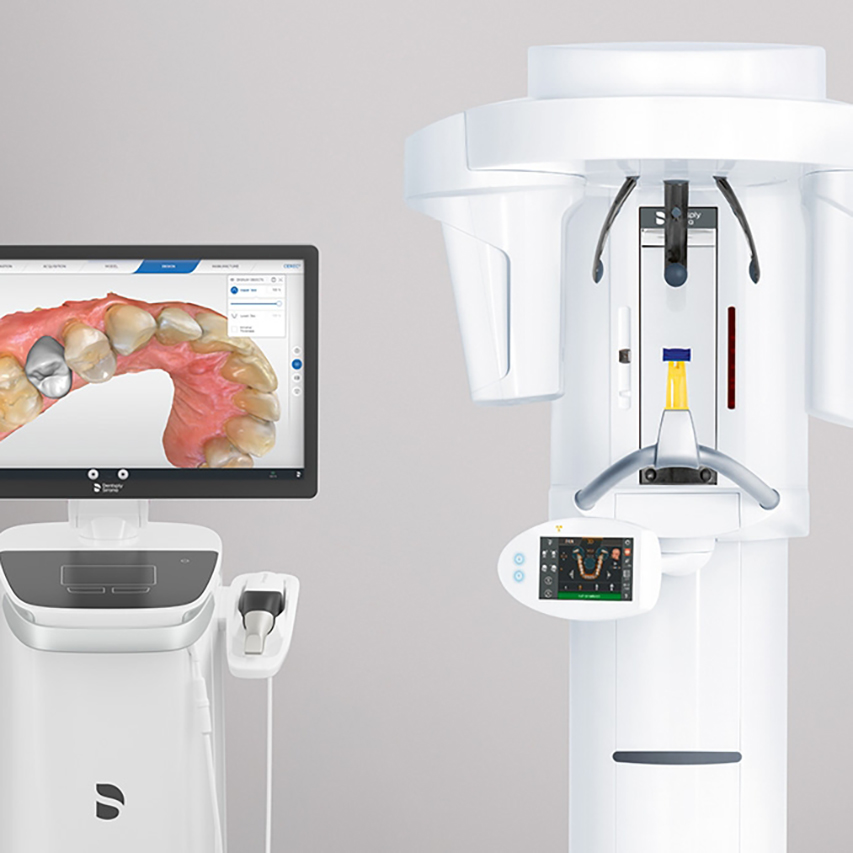The Sirona cone beam system is quickly becoming the gold standard in digital imaging for dental practices. Its high resolution results, ease of use, and connection to preventative dentistry make it the preferred technology for many dentists seeking more efficient, accurate scans.
As with traditional CT systems and dental x-rays, the basic premise of a Sirona cone beam remains the same: Dentists need dental imaging to create treatment plans for their patients.
There are some key differences with the Sirona cone beam CT and several benefits from its use in a dental practice.
Here’s why the Sirona cone beam is the obvious choice for biological dentists.
What is the Sirona cone beam scan?
The Sirona cone beam scan is a digital imaging system that offers high-resolution, 3D images of a patient’s dental structure. This includes soft tissue, the surrounding jaw, and nerve pathways.
What type of technology is used to create Sirona Cone Beam? The technology used to create the Sirona cone beam is advanced digital radiography.
This cone-beam computed tomography system (CBCT) captures data using cone-shaped x-ray beams that rotate around a patient’s head. From there, computer processing creates 3D images of that data to give a dental provider a complete picture of a patient’s oral health.
What does the “Cone Beam” refer to? The “cone beam” refers to the cone-shaped x-ray beam that captures data on an initial scan.
It’s that beam shape that allows for a variety of angles in the resulting data, essentially a surgical slice, rather than the limited views offered by other imaging systems.
Benefits of Sirona 3D CBCT
Solid oral health is important to overall health. Systems like a dental cone beam give dentists a better understanding of a patient’s dentition and any issues that may be waiting below the surface.
High-quality imagining can prevent tooth decay and result in more accurate surgical care. It can help a dentist diagnose conditions like sleep apnea, TMJ, and dental cavitations, and better inform endodontics.
Imaging that gathers data on not only a patient’s teeth but the surrounding sinuses, jaw, and skull informs whole-person care. It’s a critical piece of keeping patients healthy in the long-term.
This cutting-edge device offers a number of additional benefits to both patients and providers. Notable benefits of the Sirona cone beam CT include:
- Detailed 3D images: The system’s field of view (FOV) provides more detailed dental images. The result is better patient treatment plans. It also allows dentists to notice problems before they advance to a stage where more extreme responses are needed.
- More accurate scans: The Sirona cone beam results in the most accurate scans to plan for complex procedures. That includes root canals, orthodontic correction, dental implants, and restorations.
- Rapid imaging technology: This CBCT machine can scan multiple areas at once. This reduces exposure to radiation and results in a faster process for the patient, without sacrificing high-quality images.
- Ease of use: The patient doesn’t need to be in a certain position for the scans or sit through several rounds of x-rays from different angles. One extraoral scan offers 360-degree, panoramic x-ray views of your teeth, all the way down to the root.
- Compact footprint: The Sirona cone beam CT is less bulky than traditional CT machines or x-ray systems. This makes it easier for dental practices to offer scans on site rather than sending patients to a third party, improving overall workflow.
- Flexible features: Depending on the model, 3D cone beam systems can include additional features like 2D imaging and cephalometric (ceph) arms on the Sirona Orthophos machines. Imaging is then efficient and based on the patient’s needs.
- Whole-body approach: CBCT systems give dentists a visual of issues with a patient’s teeth and how their teeth interact with the surrounding skeletal structure. It’s a more well-rounded approach to dentistry.
CBCT vs. X-Ray vs. CT
The basic premise of CBCT is similar to x-rays and CT. Each imaging technology provides dentists with imaging to inform patient care.
Traditional x-rays are often used to diagnose early cavities and often involve bitewing radiographs. If you’ve ever bitten down on a piece of film, you’ve had one of these x-rays. (You also know how uncomfortable and lengthy this process can be.)
CBCT and CT scans are used to get a closer look at issues that may come up in a traditional x-ray. They are also important diagnostic tools in dentistry and endodontics.
For instance, 3D imaging can help differentiate between a cavity that can be reversed versus one that must be restored. CBCT is also preferred to determine the need for root canals, which should only be performed under exact circumstances.
What is the difference between a CT scan and a CBCT scan? The main difference between a CT scan and a CBCT scan is the shape of the beam.
In a CT scan, fan-shaped beams rotate while patients are moved into the field of view for their scans. They are commonplace in hospital settings and imaging centers where doctors need a quick look inside a patient before determining a course of action.
In cone beam imaging solutions, the beams are cone-shaped, rotating around the patient. The beams cover a larger surface area, making them more efficient than CT scans. This reduces radiation risk to the patient, as you’ll need fewer scans with a CBCT system.
CBCT systems have become an essential tool in dentistry as more practices recognize the need for preventative care.
Is the radiation from a Sirona cone beam CT dangerous?
It’s normal to be concerned about radiation exposure, no matter what kind of scan you’re getting at the dentist’s office. A good dentist will encourage you to ask questions about radiation exposure and any toxic materials that you may be exposed to.
The benefits of CBCT scanning far outweigh the limited risks involved with the radiation dose. Compared to a conventional CT scan, CBCT offers patients low-dose radiation with rapid imaging. That means fewer scans and less exposure time.
Experience the Sirona Cone Beam for Yourself
As a biological dentistry practice, we believe in a whole-body approach to oral health. We specialize in preventative care and biomimetic methods that reduce the need for invasive dental procedures down the line.
That includes laser dentistry and the cutting edge in x-ray technology.
The Sirona cone beam 3D system helps us meet our needs as a practice. It informs how we work with our patients and the treatment plans we present to those who trust us with their care. It allows us to see problems before they start.
Are you ready to upgrade how you think about your oral health? Book an appointment today at our Manhattan or East Hampton offices to see the Sirona cone beam for yourself.




